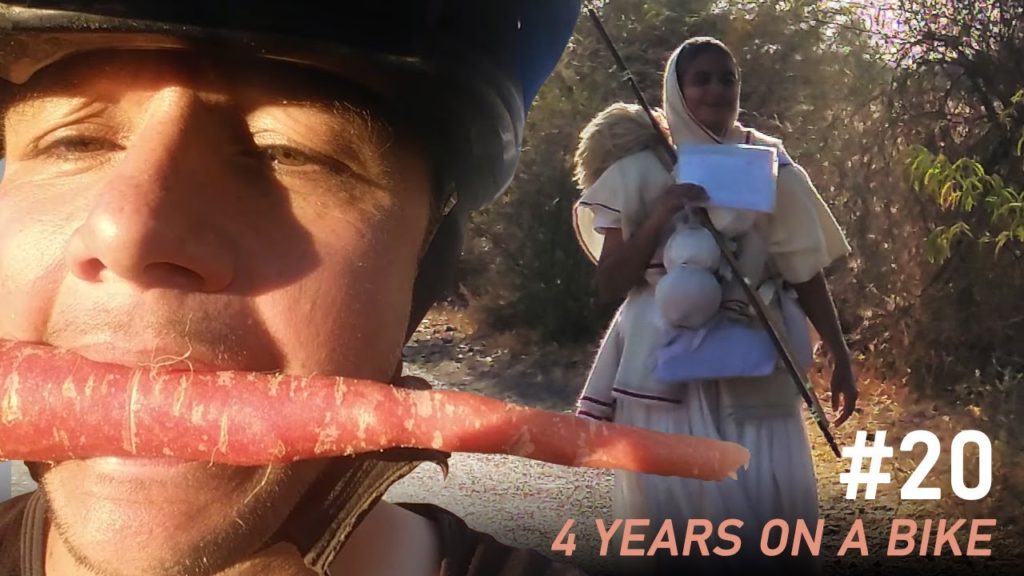Support the creation of the next episodes on:
My bicycle touring:
I arrive by chance at a big lake with pelicans in the middle of the mountains on New Year’s Eve. On the top of the hill I have a free hotel and restaurant and almost fall over due to a fairytale view (the last 3 photos). The monks are open-minded people and in a moment I am watching how one of them is preparing a meal consisting of many vegetable dishes. I almost lose the last vestiges of faith when a monk prays to a colorful rider on a horse-drawn in wood. Everywhere monkeys, parrots, and peacocks but I’m afraid of tigers because they ate somebody a few days ago in the neighboring village (I attach a photo). In the twilight on New Year’s evening, I get lost in the country streets to reach the hidden store with alcohol. They have whiskey for 7$, small vodkas of 100 ml for 0.7$, but I choose strong beer 8% Bullet for 1.5$.
——-
Hanuman (Devanagari हनुमान, trl. Hanumān) – in Hinduism the minister of Sugriva, king of the apes, devoted servant of Rama. The hero of Ramayana took part in the war with the demon Ravana caused by the abduction of Sita, the wife of Rama, to Sri Lanka. His image was on a flag stuck in the chariot of Krishna and Arjuna [1] (guarantees victory, vanara). Just bicycle touring.
Hanuman (/ H ʌ n ʊ ˌ m ɑː n /, Sanskrit: हनुमान्, IAST: HANUMAN) is the god of Hindu and the divine vanara companion of god Rama. Lord Hanuman is one of the main characters in the Hindu epic Ramayana. He is a staunch devotee of Rama and one of the chiranjeevis. He is also mentioned in several other texts, such as the epic Mahabharata and various Puranas. Lord Hanuman is also the son of the wind god Vayu, who in several stories played a direct role in the birth of Lord Hanuman. There is largely no evidence of worship of Lord Hanuman in these texts, and also in most archaeological sites. According to Philip Lutgendorf, an American Indologist, the theological significance of Lord Hanuman and devotion to him appeared about 1000 years after composing the Ramayana, in the second millennium AD, after the advent of Islamic rule in the Indian subcontinent. The saints of the bhakti movement, such as Samarth Ramdas, placed Hanuman as a symbol of nationalism and resistance to persecution. In the modern era, its iconography and temples were increasingly common. He is regarded as the perfect combination of “strength, heroic initiative and assertive perfection” and “loving, emotional devotion to his personal god Rama” as Shakti and Bhakti. And bicycle touring… In later literature, he is sometimes depicted as the patron god of martial arts such as wrestling and acrobatics, as well as activities such as meditation and hard science. It symbolizes the human perfection of inner self-control, faith and service to the cause, hidden behind the first impressions of the Vanara ape-like creature. Some scholars have identified Lord Hanuman as a potential inspiration for Sun Wukong, the character of the Monkey King in the Chinese epic adventure Journey to the West. Hanuman – bicycle touring towards God Hanuman.
The meaning or origin of the word “Hanuman” is unclear. In the Hindu pantheon, deities usually have many synonymous names, each based on some noble characteristic, attribute, or reminder of a mythical act performed by that deity. One interpretation of the word “Hanuman” is “a person with a disfigured jaw.” This version is supported by a Puranic legend in which little Hanuman confuses the Sun with a fruit, heroically tries to reach it, and is injured in the jaw for this attempt. Hanuman combines the two most cherished traits of the Hindu tradition of bhakti worship – sakti: “heroic, strong, assertive perfection” and “loving, emotional devotion to a personal God.” The linguistic varieties of “Hanuman” include Hanumat, Anuman (Tamil), Hanumantha (Kannada), Hanumanthudu (Telugu). Other names include: Anjaneya, Anjaniputra (Kannada), Anjaneyar (Tamil), Anjaneyudu (Telugu), Anjanisuta – all this means “son of Anjana” Kesari Nandana or Kesarisuta, based on his father, which means “son of Kesari” Vayuputra: son of Vayu devaboga Wiatru Vajrang Bali / Bajrang Bali, “strong (bali) who had limbs (anga) as hard or as hard as vajra (diamond)”; the name is widely used in the rural areas of northern India Sankata Mochana, “removing dangers, difficulties and obstacles” (sankata) Māruti, “son of Maruta” (another name Vayu deva) Kapeeshwara, “monkey ruler” Rama Doota, “messenger (doota) Lord Rama “Mahakaya, the gigantic” Vira, Mahavira, “the bravest” Mahabala / Mahabali, “the strongest” Panchavaktra, “the five faces” Hanuman – The end of bicycle touring via wilderness.


AloJapan.com